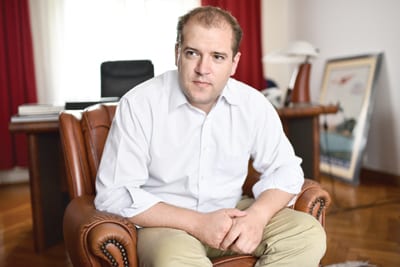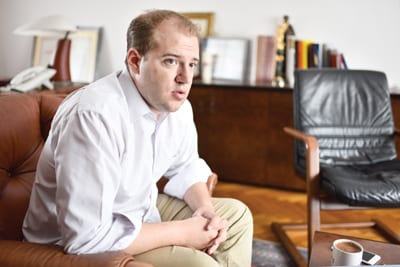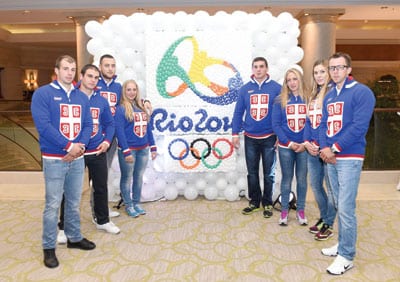The Summer Olympic Games in Rio de Janeiro will officially open on 5th August, but the journey to Brazil has already been taken by the management of Serbia’s Olympic mission, which will include a total of 104 athletes in 14 sports
The head of our Olympic mission is Damir Štajner, executive director of the Olympic Committee of Serbia, who is making his debut in this role at the Summer Olympics, but who has experience from the Winter Olympics in Sochi, the Youth Olympic Games in Nanjing and the Summer Olympic Festival, and who, along with that, has spent the last four years concerning himself on a daily basis with the preparations of our Olympic athletes and their programmes for preparation and competition, maintaining contact with them, their coaches and heads of sporting federations.Štajner was the first operative of the “Rio 2016” project, on whom the success of our athletes at the Olympic Games will depend.
Apart from the sporting aspect of our athletes, what is the essence of the “Rio 2016” project that you have worked on together with all members of the Olympic Committee of Serbia?
– The “RIO 2016” project began immediately after returning from the Olympic Games in London and in essence, it is about financial, professional and complete logistic support for athletes to achieve top sporting results. All athletes are placed into appropriate categories on the basis of which they receive a certain amount of funding to continue their training process, further their sporting progress and participate in qualifying competitions for participation in the Olympic Games and other major competitions.
In short, that is the essence of the “Rio 2016” project, with the additional aspect that we are also trying to secure sponsors for our Olympians. Logistical support implies the daily engaging of our medical team that takes care about the health of our athletes and resolves the problem of specific sports injuries, which if necessary also involve experts and medical institutions from abroad.
This support also includes the engaging of psychologists, nutritionists etc. In all of these areas, we have established cooperation with institutions who do that or who are recognised by the Law on Sports, and in all of this, we are only the generator of a programme in which there are many participants. From the direct participant of athletes and their coaches, through national sports federations, the Ministry of Youth and Sports, the sponsorship pool, the Republic Institute for Sport and Sports Medicine, to the Anti-Doping Agency of Serbia – in other words, all factors identified in the system of sports in Serbia.
Did you have a problem with the financing of the “RIO 2016” project?
– The strength of the “RIO 2016” project is that we don’t only have one source of funding, rather we secure money from several sources. That’s good because when we get less funding than anticipated from one line (for whatever reason) we can rely on another and athletes and their preparations will not suffer. I am proud to be able to say that, given the modest possibilities that we have as a country, athletes are provided with solid and stable conditions.

Of course, we cannot measure ourselves against the richest countries. Let’s say that one boat costs the same for the British, or the Germans, or for us. Still, we succeed in securing all the necessary conditions for the training and advancement of our top athletes, who succeeded through our programmes to reach the level required for the Olympic Games. A recent analysis showed that 95 per cent of athletes who will participate in the Olympic Games in Rio de Janeiro will be covered by our programmes.
How important is the sponsor pool for the realisation of the “RIO 2016” project, and how much money from your own activities have you invested in our Olympic sport?
– We are certainly proud of the contribution of the sponsor pool, but it should be noted that the Ministry of Youth and Sports, or the State, is our most important partner in financing the preparations and performances of our athletes at the Olympic Games. The Ministry of Youth and Sports (MYS) has a dominant share in financing and, roughly speaking, the ratio of funds from the state budget through the MYS and those that the Olympic Committee of Serbia(OCS) acquired its activities is 60 to 40 per cent in favour of the MYS.
We are certainly proud of the contribution of the sponsor pool, but it should be noted that the Ministry of Youth and Sports, or the State, is our most important partner in financing the preparations and performances of our athletes at the Olympic Games
It is an unwritten rule that in the first year of the Olympic cycle, the share of funds set aside by the State is the smallest and in that the biggest share is sponsorship money, while this proportion increases as the Olympic Games approach. This year, however, this is not the case due to the savings proclaimed at the state level, so that in the Olympic year the share of sponsorship funds is greater than state funds, but we at OCS, like all athletes, are eternally grateful for what the state is doing for our sport, first and foremost for Olympic sports.
What is the share of funds from public companies in sponsorship funds?
– We are a sports organisation which functions in the field of financing according to transparent business models. In the sponsor pool, we do not have a single public enterprise, although there were sporadic short-term arrangements.
We strive to function commercially in relation to partners and members of our sponsorship pool are strong international companies operating in Serbia, starting with Delhaize, which is our general sponsor, then Vojvođanska Banka, not to mention further. These are all international companies that very clearly recognise the validity of some business deals. We offer some value and in return we expect this value to be paid. Our partners are stable companies and, unlike many sports organisations, we have no delays when it comes to them fulfilling their obligations. Thanks to such relationships we have stable funding, which is extremely important in current economic conditions.
Unfortunately, due to general market conditions, the sums of our sponsorship contracts cannot be compared even with some neighbouring countries, firstly Hungary, and not even Romania. However, we are satisfied because within the framework that this country and its economy can submit this is fair and stable, which is the most important factor.
Have you calculated how much it costs for the four-year programme of an Olympian who will compete in Rio for a place in the final and for an Olympic medal?
– That could be calculated, but the average cost of each athlete would not provide exact figures. There are sports that are extremely expensive, not because of expensive equipment and gear, but rather because the system of qualification for the Olympics in that sport is very long and expensive.

This primarily relates to sports like tennis, taekwondo or judo, for which an Olympic passport is obtained on the basis of placement on the ranking list, for which points are collected throughout the entire Olympic cycle. For some sports Olympic qualification is reduced to a single competition, while in some sports – like athletics and swimming – the Olympic standard can be fulfilled in domestic competitions, certainly with respect for the provisions of international federations.
The most expensive individual programme for Rio cost about €60,000 and that entailed everything – from preparation, competition, engaging coaches, additional experts from other areas, procuring equipment, funds for supplementation etc. Programmes vary from sport to sport and from athlete to athlete, so some programmes cost €15,000. It is known that the most expensive qualifications are for team sports… But it’s not all about the money. Sometimes sports and athletes need different types of support – training and education of coaches, hiring experts for nutrition and recovery, psychologists, completing a professional team that will take care of top athletes on a daily basis.
The Executive Board of OCS decided at the start of the Olympic cycle to make the criteria for the Olympic Games stricter, in order to increase the competitiveness of our athletes for high placements
Is it true that in these Olympic cycle candidates for participation in the Olympic Games in individual sports received greater attention and more resources than ever before?
– After the Beijing Games in 2008 and the arrival of Vlade Divac at the head of the Olympic Committee, we set up new programmes whose base was to use some kind of “protectionism” to enable the better status of individual sports that were then lagging behind in comparison to team sports. Because of that, we redesigned the programme and in individual sports, we went much deeper, down to the minutest detail, in relation to team sports. Team sports have the capacity to carry that which we do more with individual sports. Such a relationship contributed to 95 per cent of athletes who were in our programmes succeeding in making the Olympic quota or achieving the Olympic standards needed for Rio.
In addition to that, a significant number of these athletes were in our program for Olympic talent from the very start of their Olympic career and prior to their appearance at the Olympic Games in Rio, they gained experience in the Olympic Youth Games and at the European Olympic Youth Festival for young athletes…
Some 104 athletes from Serbia will compete at the Olympic Games in Rio de Janeiro in 14 sports, 11 less than in London four years ago. How would you explain that with regard to all of the aforementioned?
– You cannot escape from statistics, but they can show a false picture of reality.
Our “RIO 2016” project was at the level of the London 2012 project, and that means 110 to 115 athletes. On the other hand, the Executive Board of OCS decided at the start of the Olympic cycle to make the criteria for the Olympic Games stricter, in order to increase the competitiveness of our athletes for high placements, which it has the right to do according to the Olympic Charter.

Therefore, in Rio, a number of athletes will not participate who could, according to the criteria of international sports federations, participate on the basis of B standards. We also gave up on invitations, or “wild cards” that we could count in some sports and that is one of the reasons why we will have 12 fewer athletes in Rio than in London.
However, even in such a situation we could have had the same number of athletes if only one of our teams had, as was expected, achieved Olympic qualification [men’s volleyball team]. The number of participants is slightly smaller, but we expect more effective results.
As we’re already talking about it, can you be specific when it comes to the expectations of the OCS?
– Our job is to motivate athletes, not to expose them to pressure We will be satisfied if the number of medals won and the number of placements among the top eight or 10 is greater than in London. That would be a historic achievement, because we should not forget that Serbia is a country with a small population and a weak financial base when it comes to sport, albeit a country with great sporting potential.
In order to go further we must improve the conditions in which our sports clubs live and work in most sports. If we do not succeed in that it could hit us in the head, perhaps not for the next Olympic Games in Tokyo, but certainly for those in 2024
Top sport today is a profession and entertainment of the rich, and Serbia, despite everything, has very good standing in that company. In order to go further, we must improve the conditions in which our sports clubs live and work in most sports. If we do not succeed in that it could hit us in the head, perhaps not for the next Olympic Games in Tokyo, but certainly for those in 2024.
In order to improve conditions for practising sport, it is essential to have state assistance. Are you were satisfied with its role to date?
– Generally speaking, those of us who are engaged in sport in this or some other way should not complain about the attitude of the state, but rather we have to be satisfied that we have the Law on Sports, the Strategy for Sport, national sports awards and a favourable climate in the public media which is certainly influenced by the state with its positive attitude towards sport. If this ratio is reduced down to the amount of money that the state sets aside, it is clear that we are lacking money; that higher investments would be returned via top results, but we in sport also know that other areas of social action lack money as much as we do. Quite simply, given the economic situation, the state can set aside as much as it does and we must not be dissatisfied.
104 Serbian Olympians in Rio
The Serbian Olympic team in Rio de Janeiro will include 104 athletes, 55 in 11 individual sports and 49 members of four teams in three team sports: athletics – 13, cycling – 2, water polo – 13, rowing – 4, kayaking – 10, female basketball players – 12, male basketball players – 12, female volleyball players – 12, swimming – 4, wrestling – 3, table tennis – 1, shooting – 9, taekwondo – 2, tennis – 6, judo – 1.
Fourth Independent Appearance
Serbia returned to the Olympic stage as an independent country in Beijing in 2008, 96 years after its debut at the Olympic Games in Stockholm in 1912, where it competed with two athletes who did not achieve significant results.
In Beijing, three medals were won – silver for swimmer Milorad Čavić, bronze for tennis player Novak Đoković and bronze for the water polo team.